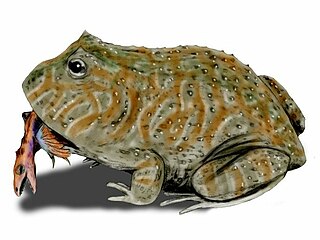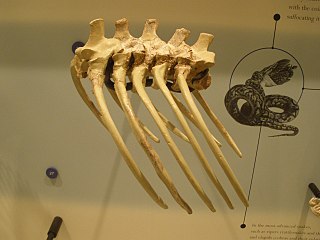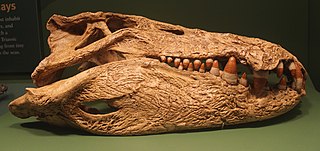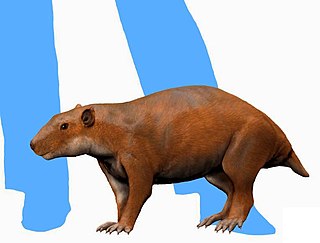 W
WAraripesuchus is a genus of extinct crocodyliform that existed during the Cretaceous period of the late Mesozoic era some 125 to 66 million years ago. Six species of Araripesuchus are currently known. They are generally considered to be notosuchians, characterized by their varied teeth types and distinct skull elements. This genus consists of six species: A. buitreraensis, discovered in Argentina, A. wegeneri, discovered in Cameroon and Niger, A. rattoides, discovered in Niger, A. tsangatsangana, discovered in Madagascar, A. gomesii, discovered in Brazil and another species discovered in Argentina, A. patagonicus.
 W
WBeelzebufo ampinga was a particularly large species of prehistoric frog described in 2008. Common names assigned by the popular media include devil frog, devil toad, and the frog from hell.
 W
WMadtsoia is an extinct genus of madtsoiid snakes. It is known from the Eocene of Argentina, the Paleocene of Brazil, the Late Cretaceous (Campanian) of Spain, the Late Cretaceous of India, and the Late Cretaceous (Maastrichtian) of Madagascar and the Coniacian of Niger. Recovered vertebrae of M. pisdurensis are 1.83 centimetres (0.72 in) long and 4.35 centimetres (1.71 in) tall) and pertain to a snake that was approximately 5 metres (16 ft) long.
 W
WMahajangasuchus is an extinct genus of crocodyliform which had blunt, conical teeth. The type species, M. insignis, lived during the Late Cretaceous; its fossils have been found in the Maevarano Formation in northern Madagascar. It was a fairly large predator, measuring up to 3 m (9.8 ft) with a weight up to 360 kg (790 lb).
 W
WMajungasaurus is a genus of abelisaurid theropod dinosaur that lived in Madagascar from 70 to 66 million years ago, at the end of the Cretaceous Period, making it one of the last known non-avian dinosaurs that went extinct during the Cretaceous–Paleogene extinction event. The genus contains a single species, Majungasaurus crenatissimus. This dinosaur is also called Majungatholus, a name which is considered a junior synonym of Majungasaurus.
 W
WMasiakasaurus is a genus of small predatory noasaurid theropod dinosaurs from the Late Cretaceous of Madagascar. In Malagasy, masiaka means "vicious"; thus, the genus name means "vicious lizard". The type species, Masiakasaurus knopfleri, was named after the musician Mark Knopfler, whose music inspired the expedition crew. It was named in 2001 by Scott D. Sampson, Matthew Carrano, and Catherine A. Forster. Unlike most theropods, the front teeth of M. knopfleri projected forward instead of straight down. This unique dentition suggests that they had a specialized diet, perhaps including fish and other small prey. Other bones of the skeleton indicate that Masiakasaurus were bipedal, with much shorter forelimbs than hindlimbs. M. knopfleri reached an estimated adult body length of around 2 metres.
 W
WRahonavis is a genus of bird-like theropods from the Late Cretaceous of what is now northwestern Madagascar. It is known from a partial skeleton found by Catherine Forster and colleagues in Maevarano Formation rocks at a quarry near Berivotra, Mahajanga Province. Rahonavis was a small predator, at about 70 centimetres (2.3 ft) long and 0.45-2.27 kg, with the typical Velociraptor-like raised sickle claw on the second toe.
 W
WRapetosaurus is a genus of titanosaurian sauropod dinosaur that lived in Madagascar from 70 to 66 million years ago, at the end of the Cretaceous Period. Only one species, Rapetosaurus krausei, has been identified.
 W
WSimosuchus is an extinct genus of notosuchian crocodylomorphs from the Late Cretaceous of Madagascar. It is named for its unusually short skull. Fully grown individuals were about 0.75 metres (2.5 ft) in length. The type species is Simosuchus clarki, found from the Maevarano Formation in Mahajanga Province, although some fossils have been found in India.
 W
WVintana sertichi is an early groundhog-like mammal dating from the Late Cretaceous, approximately 66 million years ago. Scientists found the lone fossil, a skull, on Madagascar's west coast in the Maastrichtian Maevarano Formation.